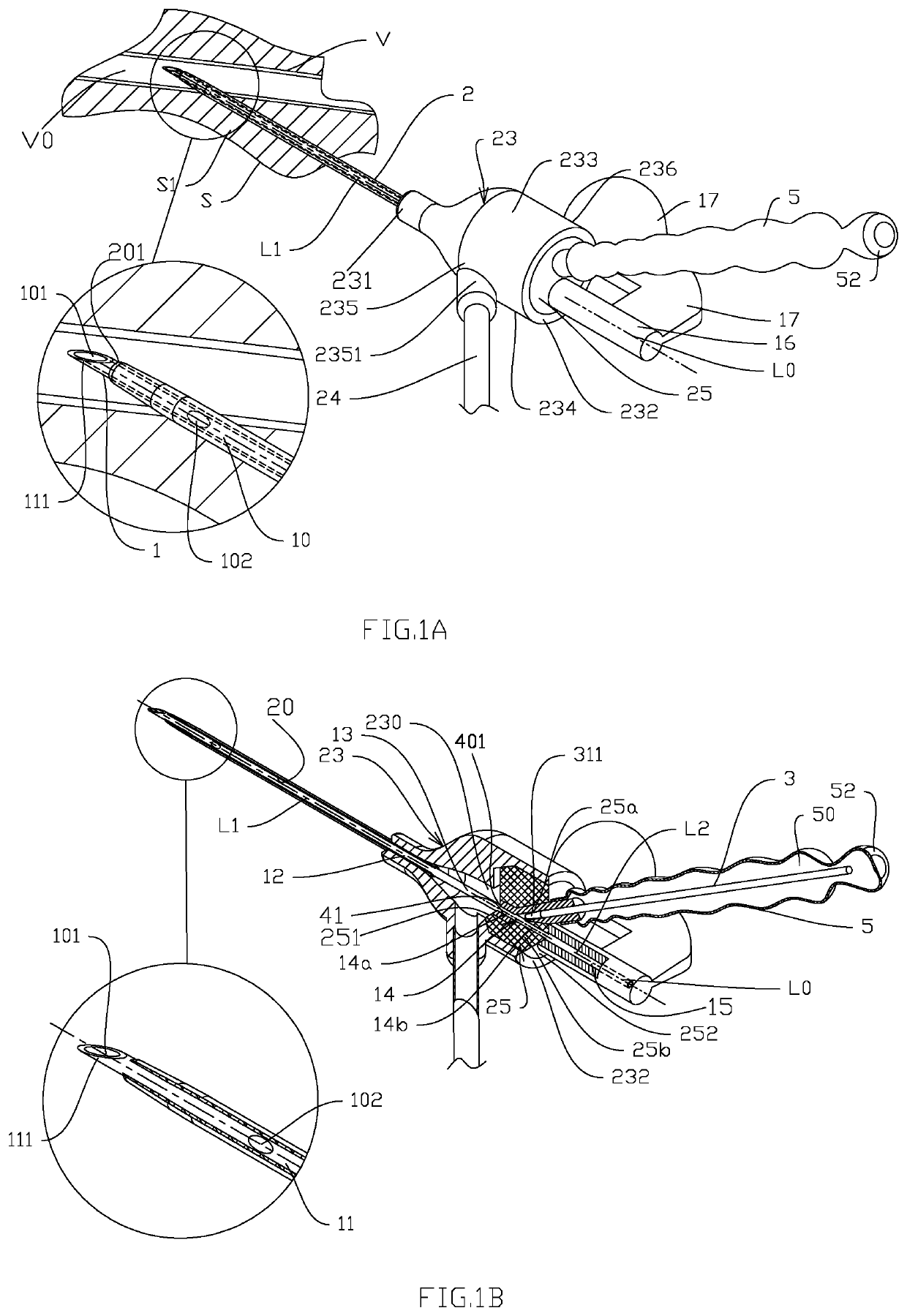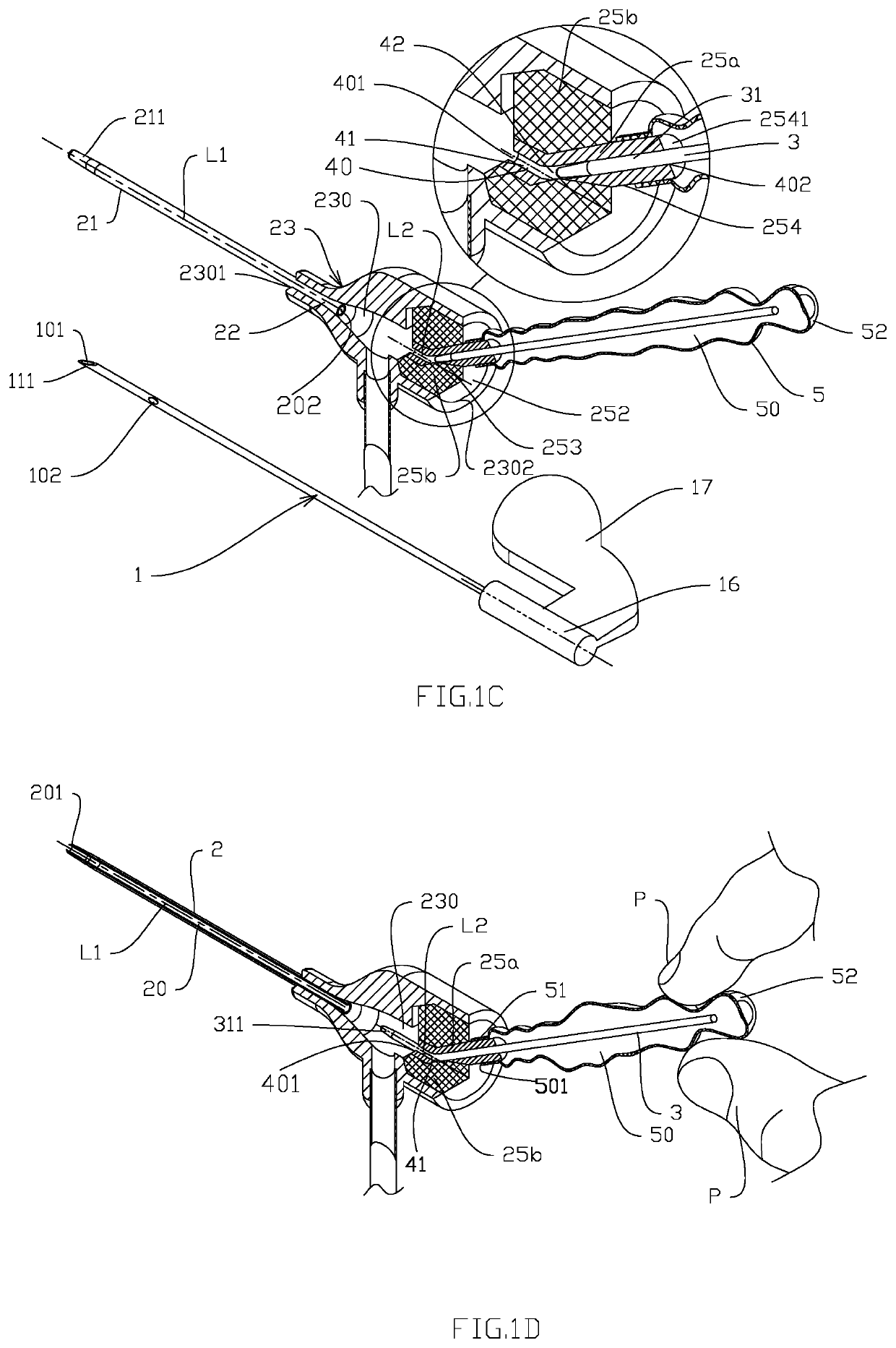Venous Catheter Device Capable of Being Sealed
- Summary
- Abstract
- Description
- Claims
- Application Information
AI Technical Summary
Benefits of technology
Problems solved by technology
Method used
Image
Examples
embodiment 1
[0078]As shown in FIGS. 1A, 1B, 1C, 1D, 1E and 1F, the occludable venous catheter device of Embodiment 1 of the present invention comprises: a rigid needle tube 1 for puncturing skin S and venous wall V, a needle tube base 16, a venous catheter 2, a venous catheter base 23, a sealer 25, an occluding wire 3, a occluding wire guide passage 40 and an isolating element 5; the needle tube 1 is hollow inside and has a needle tube lumen 10, a bottom portion 15, a front portion 11 and a sharp front end 111, the front portion 11 of the needle tube 1 is located inside the venous catheter lumen 20, the sharp front end 111 is exposed from a front-end opening 201 of the venous catheter 2 during puncture, the needle tube lumen 10 has an opening 101 at the front end 111 of the needle tube 1, and the front portion 11 of the needle tube 1 has a side opening 102 near the front end 111 of the needle tube 1; a connecting portion 12 of the needle tube 1 is located in the area of a front end 231 of the v...
embodiment 2
[0084]FIGS. 2A, 2B, 2C, 2D, 2E, 2F, 2G, 2H and 21 show a venous catheter device of Embodiment 2, the biggest difference from Embodiment 1 is that, in the initial state, the central axis L2 of the straight tube portion 41 of the guide passage 40 is not coaxial but parallel to the central axis L1 of the venous catheter 2. FIG. 2A shows that the needle tube base 16 is located below the isolating element 5, and the upper surface 233 of the venous catheter base 23 has an arched window 2331, a part of the hard portion 25a of the sealer 25 is exposed in the arched window 2331. The hard portion 25a of the sealer 25 is connected with a rotation handle 255, which is connected with the hard portion 25a of the sealer 25 through a neck 2551; the section view of FIG. 2B shows that the blind end 311 of the front section of the occluding wire 3 is located in the guide passage 40 and adjacent to the rear-end opening 402. The front-end opening 401 of the guide passage 40 faces a convex 2303 of the ch...
embodiment 3
[0085]FIGS. 3A, 3B, 3C and 3D show a venous catheter device of Embodiment 3, the biggest difference, compared to method of making the central axis L2 of the straight tube-shaped guide passage 40 on the sealer 25 colinear with the central axis L1 of the venous catheter 2 by rotation in an externally-isolated manner in embodiment 2 is that, the guide passage 40 is formed by an independent hollow passage element 4, and the collinearity is realized by translation rather than rotation of external in an externally-isolated manner.
[0086]As shown in the section view FIG. 3A, there is a tubular convex 2332 on the upper surface 233 of the venous catheter base 23, the tubular convex 2332 is sleeved with the passage element 4, the passage element 4 has an extended section 43 extending from the outer surface 2333 of the tubular convex 2332 of the venous catheter base 23, the inner surface of the front end 51 of the isolating element 5 is connected with the outer surface of the tubular convex 233...
PUM
 Login to View More
Login to View More Abstract
Description
Claims
Application Information
 Login to View More
Login to View More - R&D
- Intellectual Property
- Life Sciences
- Materials
- Tech Scout
- Unparalleled Data Quality
- Higher Quality Content
- 60% Fewer Hallucinations
Browse by: Latest US Patents, China's latest patents, Technical Efficacy Thesaurus, Application Domain, Technology Topic, Popular Technical Reports.
© 2025 PatSnap. All rights reserved.Legal|Privacy policy|Modern Slavery Act Transparency Statement|Sitemap|About US| Contact US: help@patsnap.com



